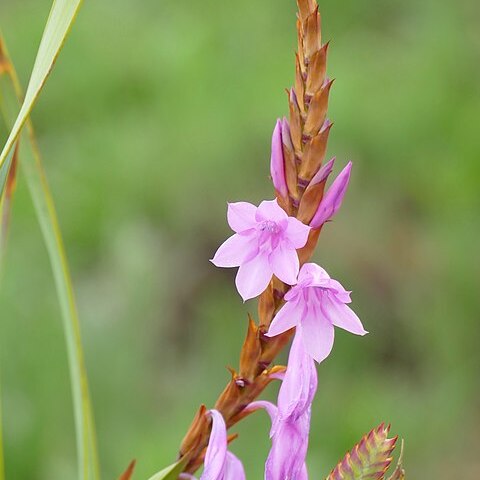Plants 600-1200 mm high, growing in clumps. Corm subglobose, 30-50 mm diam.; tunics coarsely netted. Stem sometimes inclined below, simple (abnormally with 1 or 2 branches). Leaves 4 to 7, mostly ± basal, usually half as long as spike or reaching to base of spike, lanceolate or narrowly lanceolate, (10-)15-30 mm wide, midrib hardly and margins moderately to strongly thickened and hyaline, upper leaf or leaves partly sheathing; bract-like cauline leaves 3 or more, overlapping. Spike densely 30-to 60-flowered, internodes 4-8 mm long; bracts dry and cinnamon-brown with darker margins, 18-30 mm long, clasping stem in lower 1/3-2/3, strongly overlapping, 2 to 3 internodes long, often apiculate to attenuate, inner shorter and concealed, deeply forked apically for 2 mm or more. Flowers zygomorphic, weakly bilabiate, pink to purple, or maroon (rarely white), often with darker median streak in basal half of tepals; perianth tube with lower part 14-20 mm long, shortly exserted from bracts, upper part ascending to horizontal and funnel-shaped, 10-15 mm long, 8 mm diam. at mouth; tepals lanceolate, 16-25 x 8-11 mm, upper three spreading and lower three nearly horizontal. Filaments unilateral and arcuate, 10-15 mm long, included in tube; anthers 7-9 mm long, whitish to mauve or violet. Style arching over stamens, dividing near anther apices, branches 4-6 mm long. Capsules narrowly ovoid, 10-14 mm long. Seeds unknown.
More
Cormous geophyte, up to 1.2 m high; plants usually in clumps. Stem bracts rarely inflated. Leaves 4-7; blade 15-30 mm wide, margins and midrib hardly or not at all thickened. Flowers: in a 30-60-flowered spike, internodes 4-8 mm long; bracts relatively broad with spike axis usually hidden by bracts, stem bracts rarely inflated, bracts dry, dark brown; perianth with segments 16-25 mm long, pink to purple or maroon; Dec.-Mar.
Cormous herb, up to 1.2 m high. Plants growing in clumps. Intemodes of spike 4-8 mm long. Tepals 16-25 mm long. Spike 30-60-flowered. Bracts dry, dark brown. Flowers pink to purple or maroon.

